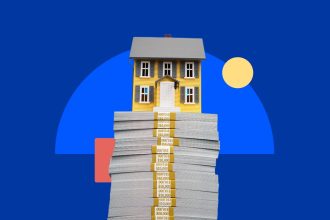eclipse images/Getty Images/Illustration by Issiah Davis/Bankrate
Key takeaways
- An open-end mortgage provides financing to help you buy a home now and renovate it in the future.
- Open-end mortgages work similar to a home equity line of credit, but you can only use the drawn funds for upgrades to your property.
- Few mortgage lenders offer open-end loans. There are other loan options that wrap the purchase and renovations into one mortgage, and other ways to pay for improvements in general.
An open-end mortgage allows you to finance a home now, with the option to borrow more down the road for home improvements. With this type of loan, you’ll only pay interest on what you actually borrow, but there are downsides, too. Here’s an overview.
What is an open-end mortgage?
With an open-end mortgage, you’ll first finance your home purchase, then borrow more over time, at your discretion, to renovate the property. In essence, you’re increasing your loan principal. This differs from a closed mortgage, which provides a set amount of funds and doesn’t allow you to borrow more.
How does an open-end mortgage work?
Like a home equity line of credit (HELOC), with an open-end mortgage, you’ll have a draw period, or window, to borrow more money, also known as “future advances.” Unlike a HELOC, however, this money can only be used to improve your home.
Whether you draw more funds or not, you’ll continue to pay principal and interest payments on the amount you used to buy the home.
Example of an open-end mortgage
Let’s say you were approved for an open-end mortgage in the amount of $500,000 and buy a home for $440,000. You’ll begin repaying principal and interest on the $440,000. If you decide to draw on the remaining $60,000 ($20,000 to start, for instance), you’ll begin repaying that along with the payments you’ve been making. You’ll pay both in one monthly payment.
Open-end mortgage qualifications
Open-end mortgages are not available everywhere. If you’re able to find an open-end mortgage lender, you’ll need to get your finances in shape just like when you apply for a traditional mortgage. While requirements vary by lender, this might include:
Pros and cons of an open-end mortgage
Pros of an open-end mortgage
- Finance a home purchase and renovations with one loan and one monthly payment
- Only repay the mortgage and any extra you use
- Avoid closing costs for two loans
Cons of an open-end mortgage
- Difficult to find a lender that offers open-end loans, and some states don’t allow them
- Can’t draw more than the maximum
- Risk of borrowing more than what you can reasonably repay
Alternatives to an open-end mortgage
It can be hard to find an open-ended mortgage. If you need financing to buy and renovate a home, here are some other options:
- Fannie Mae HomeStyle Renovation loan: A conventional loan for a home purchase plus renovations worth up to 75 percent of its after-improvement value
- Freddie Mac CHOICERenovation loan: Another type of conventional loan for a home purchase plus renovations
- FHA 203(k) loan: An FHA loan for a home purchase plus renovations costing either up to or beyond $35,000 (depending if you get a Limited or Standard 203(k) loan)
- VA renovation loan: For eligible servicemembers and veterans, a VA loan for a home purchase plus renovations worth up to after-improvement value
- USDA Section 504 Home Repair loan: For very low-income homeowners in eligible locations, a USDA loan for renovations up to $40,000
- Home improvement loan: A personal loan for renovations, with amounts and rates varying by lender
FAQ about open-end mortgages
-
It depends on what you’re comparing it to. The interest rate on an open-end mortgage might be higher or lower than the rate you’d get if you refinanced or took out a HELOC or home equity loan, for instance. Of course, if later on you choose to borrow more than what you used to buy your home, you’d also pay more to repay that, plus interest.
-
Open-end mortgages are very difficult to find, and they aren’t available in every state. To get one, you might need to work with a mortgage broker who specializes in this type of loan.
-
As with any financial decision, it depends on your unique circumstances. In the case of an open-end mortgage, you might not even find a worthy option to consider. If you want a mortgage for both a home purchase and upgrades, there are many other choices, such as HomeStyle or 203(k) renovation loans.
Read the full article here
















